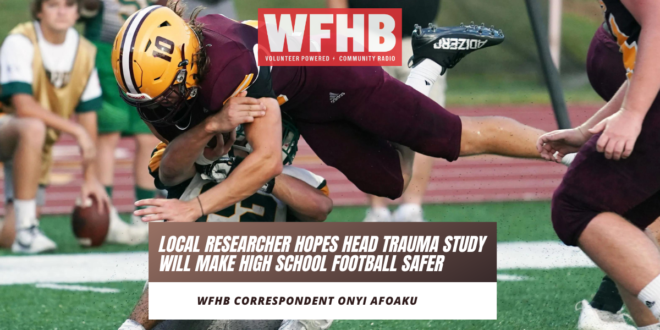Podcast: Play in new window | Download (Duration: 14:25 — 19.9MB)
Subscribe: RSS
Head trauma in sports like football has been a growing concern in the sports world. This has been partially fueled by the discovery of chronic traumatic encephalopathy (CTE), a progressive brain disease resulting from too much head trauma.
There have been numerous studies on the effects of head trauma in sports. For Dr. Kei Kawata, a professor in Indiana University’s School of Public Health, a 3.1 million dollar grant he received in 2020 has enabled him to study the effects of subconcussive head impacts, impacts that do not cause symptoms like headache and light sensitivity, on local high school football players from Bloomington High School North, Bloomington High School South, Edgewood High School, and Mooresville High School.
According to Dr. Kawata, awareness of CTE began when Dr. Bennet Omalu published a paper on his findings with Pittsburgh Steelers football players in 2005. Since then, close to 300 cases have been published and more have been diagnosed. When CTE first began to get exposure, it was feared that every athlete who played football had it. However, Kawata explains that this is not the case.

“The earlier study has tested on so many athletes that were concerned about maybe potential CTE. That’s why family members donated their brains,” said Dr. Kawata.
Parents have shown concern about the research on head trauma in sports like football. Kawata says that participation in high school football has been affected by this.
“It is declining. So, the decline is consistent, not just the past couple of years. It’s been declining over the course of a decade,” he said.
Kawata’s research looks to find out what number of hits is safe for high school football players by using technology to track the number of subconcussive hits they take and measure the effects.
Kawata first tested the effects of subconcussive hits in an experiment where he used a jugs machine to shoot soccer balls at soccer players’ heads while they performed heading exercises. After 10-20 hits, Kawata’s team saw differences in blood biomarkers, eye tracking and some balance measures. This showed them that changes were measurable. After soccer, football was the next logical step.
“So we applied that into football because football at that time [had a significant] concern about concussions, CTE, and maybe competitive impacts. We transitioned this laboratory model into this field, human study,” said Kawata.
There are several different tools that Kawata’s team uses when compiling data. One is a helmet sensor that tracks frequency and magnitude of head impacts. There’s also a patch that can be placed behind the ear to detect head movement. According to Kawata, the best tools they have are special mouthguards with three devices implanted in them. First, there is a sensor that detects when the mouthguard is in use. This prevents any false readings. Then, there is an accelerometer and a gyroscope to detect the direction of the force applied to the subject.
“Those two different sensors, accelerometer and gyroscope. They can detect linear head motion,” he said.
According to Kawata, there are factors that cause an athlete to be at higher risk for serious brain trauma. The frequency and magnitude of head impacts is the most obvious. The Centers for Disease Control and Prevention also published a study that found if a football player is younger than 14, they are at higher risk for brain disease down the line. Also, female athletes are said to be more affected by head trauma because their neck muscles are not as strong and stiff. Kawata talked about the kinds of effects he has seen while researching this topic.
“If you sustain a lot of head impact in a really short time, and you’re exposed to 20 hits in a matter of five to ten minutes, that’s really a lot of head impact in a short time,” said Dr. Kawata.
The study Kawata’s team is conducting has just finished its first year. He did say that there is a correlation between practice intensity and the amount of head impact exposure.
“Head impact has been demonized a little bit, and I agree it’s not a good thing to sustain a lot of head impact. The NCAA has reduced or prevented two-a-days… in college football,” he said.
According to Kawata, the purpose of the study is to learn how many hits are safe and how many pose a danger to players.
“There are a lot of answers, but the single answer is how many head impacts are safe and how many head impacts are shown to increase the impairments, so unsafe,” said Dr. Kawata.
Until there is more knowledge about the effects of head impacts, Kawata recommends limiting exposure as much as possible and getting plenty of rest after exposure. For more information on CTE, visit concussionfoundation.org.
 WFHB Bloomington Community Radio
WFHB Bloomington Community Radio


